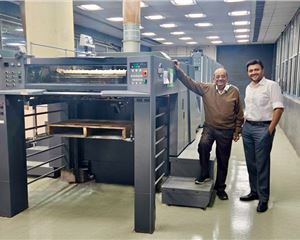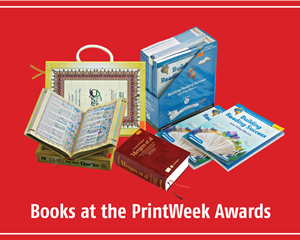Media Expo 2025: Print remains top ally for signage in India
As both digital and print signage continue to evolve, manufacturers are investing to improve quality and expand application versatility. Prabhat Prakash delves deep
25 May 2025 | By Noel D'Cunha
India’s signage industry, propelled by advancing technology and consumer demand, is continuously evolving. The market is witnessing a rapid transition between print displays and digital signage solutions. Despite the growth trajectory, several challenges persist, from market saturation to the fragmentation of the domestic industry.
Growth of digital signage
Digital signage demand is witnessing an upward trajectory driven by an increasing shift towards interactive and visually appealing advertising solutions. Metro cities like Mumbai, Delhi, Bengaluru, and Chennai are witnessing significant growth, where the demand for digital out-of-home (DOOH) advertising is surging.
Winston Pereira, executive director at Messe Frankfurt India, points out, “The digital OOH market currently stands at over USD one-billion, with expectations for it to expand to USD 2.5-billion by 2030.” The sector’s rapid development can be seen in the growing adoption of car wraps, train wraps, and digital billboards.
However, while the digital signage market is flourishing indoors, the outdoor sector has seen more cautious growth. The concern around the effectiveness of digital signage in outdoor spaces, especially with drivers having limited screen exposure, has slowed its impact.
Aditya Dadu, vice-president of Apsom Infotex, added, “Digital signage is here to stay, but it is more significant for indoor applications.” Digital billboards in public places and malls are more impactful due to prolonged exposure; they also offer higher levels of interaction as compared to print signage.
Print signage is still a market staple
As the digital signage market continues to expand, print signage remains indispensable in India’s advertising ecosystem. The Flag Company, founded by Dalvir Nagi, is tapping into this ongoing demand. The company has diversified its offerings, and it specialises in fabric-based signage, such as flags, banners, stadium branding, and modular exhibition stalls. It has created a robust business around print solutions.
Nagi says, “Flags and banners still constitute 60% of my business, though non-traditional applications like retail branding and backlit fabric light boxes are on the rise.”
Retail branding and backlit fabric light boxes now constitute 40% of the company’s sales, which reflects the growing interest in fabric-based products.
Nagi has created different weaves and fabrics for various applications. The company’s use of digital and dye-sublimation printing technologies allows for customisation and precision in creating high-quality designs. Even though digital signage is growing rapidly, print signage remains a crucial and profitable sector.
Push for better quality with innovation
Manufacturers are investing in technology to improve print quality, efficiency, and expand application versatility as digital and print signage continue to evolve and grow.
One of the notable advancements has been the introduction of UV printing technologies and eco-solvent solutions, which have seen increasing adoption in the signage sector.
Abhishek Bhatia, general manager of sales and marketing at Apsom Technologies, highlights the growing demand for UV printing solutions, particularly in Maharashtra, Mumbai, the capital, and its adjoining regions are a large signage market.
For outdoor applications, UV prints are becoming the preferred choice as the industry is moving towards longer-lasting, weather-resistant signage. “Mimaki’s eco-solvent printers, with their wide print beds and extensive colour profiles, offer superior quality and a more uniform finish compared to Chinese-made machines,” shares Bhatia. “Chinese machines are cost-effective, but lack the reliability and consistent performance of premium brands like Mimaki.”
Apsom Infotex’s introduction of the Sonik Aqua and Verve LED 2513 is are example of how manufacturers are innovating and driving the industry forward. The
Sonik Aqua’s dual application for indoor and outdoor use, combined with a six-picolitre drop size, makes it stand out in the solvent printer market.
This shift toward high-quality inkjet and UV printing technologies indicates a broader trend in the industry; consumers are pursuing better quality print outputs that make them stand out in crowded spaces.
Fragmentation and market saturation
The Indian signage market is growing, but several hurdles still exist. One major challenge that the market faces is fragmentation. Several regional players offer similar products, which has intensified the competition which making differentiation difficult.
Additionally, there is a lack of communication in the industry, which hinders collaboration. Nagi notes that one of the biggest obstacles to growth in the domestic market is limited communication, leading to missed opportunities and loss of business.
Future of the Indian signage market
India’s signage market will continue to grow; the rise of eCommerce and quick commerce will also bolster the growth. There is also an increasing demand for personalised and customised branding solutions that are driving innovation in digital inkjet and print-on-demand technologies. According to Dadu, the wallpaper market will also witness growth driven by digital inkjet printing. He estimates the market to grow at a CAGR of 20%.
Dadu also mentions that the Indian signage market will grow at 8% to 9% annually. The growing digital OOH market with newer applications in personalised signage will boost the growth of the industry.
The Indian signage market is rapidly growing and evolving, and the combo of digital and traditional print signage provides a variety of solutions that ensure businesses have several tools at their disposal to engage consumers and enhance brand visibility. Newer innovations, along with solutions for the ever-changing demands of the market, can help the industry progress and meet consumer demands.












 See All
See All